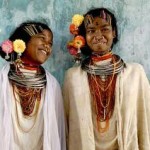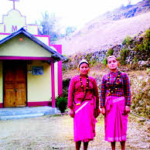 हालाँकि अब यह कई और तरह से भी सिद्ध हो चुका है की आर्यन लोगों के ३५०० हज़ार साल पहले आने की बात मैं कोई सच्चाई नहीं है .यह भ्रान्ति शायद मोहन जोदारो / हरप्पा मैं कुछ हड्डियों पर तलवार के वार सरीखे निशानों से शुरू हुयी थी जिसे आर्यों की युद्ध मैं जीत से जोड़ दिया गया था . मेहरगढ़ ,लोथल व् द्वारका की खोजों ने वह तो बहुत पहले ही ख़त्म कर दिया था .
हालाँकि अब यह कई और तरह से भी सिद्ध हो चुका है की आर्यन लोगों के ३५०० हज़ार साल पहले आने की बात मैं कोई सच्चाई नहीं है .यह भ्रान्ति शायद मोहन जोदारो / हरप्पा मैं कुछ हड्डियों पर तलवार के वार सरीखे निशानों से शुरू हुयी थी जिसे आर्यों की युद्ध मैं जीत से जोड़ दिया गया था . मेहरगढ़ ,लोथल व् द्वारका की खोजों ने वह तो बहुत पहले ही ख़त्म कर दिया था .
फिर भारतीय हैं कौन ? हमारे यहाँ इतने रूप रंग क्यों हैं .
क्यों हैं .
इस लेख मैं जो विकिपीडिया से उद्धृत है , भारतीय जेनेटिक मूल के बारे मैं बताया गया है . यह तो अब लगभग पक्का है की अंदमान व् कई और जनजातियों का ऑस्ट्रेलिया के रेड इन्दिंस से जींस मिलते हैं . इसी तरह आर्यन व् द्रविड़ियन जींस भी कुछ अलग से हैं . परन्तु दस हज़ार से भी ज्यादा वर्षों से जगह जगह से आ कर लोग भारत मैं बस रहे थे . अब हमारे जींस बहुत मिल चुके हैं .
लेख को लिंक पर क्लिक कर पढ़ें
http://en.wikipedia.org/wiki/Peopling_of_India
Peopling of India
The peopling of India is a contentious area of research and discourse, due to the debate on topics such as the Indo-Aryan migration hypothesis.[1] Some anthropologists hypothesize that the region was settled by multiple human migrations over tens of millennia, which makes it even harder to select certain groups as being truly aboriginal.[2]
Content
Early hominins of Acheulean period
The presence of intelligent hominins in the subcontinent may stretch as far back as 1,500,000 ybp to the Acheulean period.[3]
Humans and the Toba catastrophe
It has been hypothesized that the Toba supereruption about 74,000 years ago destroyed much of India’s central forests, covering it with a layer of volcanic ash, and may have brought humans worldwide to a state of near-extinction by suddenly plunging the planet into an ice-age that could have lasted for up to 1,800 years.[4] If true, this may “explain the apparent bottleneck in human populations that geneticists believe occurred between 50,000 and 100,000 years ago” and the relative “lack of genetic diversity among humans alive today.”[4]
Since the Toba event is believed to have had such a harsh impact and “specifically blanketed the Indian subcontinent in a deep layer of ash,” it was “difficult to see how India’s first colonists could have survived this greatest of all disasters.”[5] Therefore, it was believed that all humans previously present in India went extinct during, or shortly after, this event and these first Indians left “no trace of their DNA in present-day humans” – a theory seemingly backed by genetic studies.[6]
Research published in 2009 by a team led by Michael Petraglia of the University of Oxford suggested that some humans may have survived the hypothesized catastrophe on the Indian mainland. Undertaking “Pompeii-like excavations” under the layer of Toba ash, the team discovered tools and human habitations from both before and after the eruption.[7] However, human fossils have not been found from this period and nothing is known of the ethnicity of these early humans in India.[7]
The Negrito migrations
One narrative, describes Negritos, similar to the Andamanese adivasis of today, as the first identifiable human population to colonize India, likely 30-65 thousand years before present (kybp).[8][9] This first colonization of the Indian mainland and the Andaman Islands by humans is theorized to be part of a great coastal migration of humans from Africa along the coastal regions of the Indian mainland and towards Southeast Asia, Japan and Oceania.[8]
60% of all modern Indians share the mtDNA haplogroup M, which is universal among Andamanese islander adivasis and might be a genetic legacy of the postulated first Indians.[10] A 2010 study by the Anthropological Survey of India and the Texas-based Southwest Foundation for Biomedical Research identified seven genomes from 26 isolated “relic tribes” (sic) from the Indian mainland, such as the Baiga, which share “two synonymous polymorphisms with the M42 haplogroup, which is specific to Australian Aborigines.” These were specific mtDNA mutations that are shared exclusively by Australian aborigines and these Indian tribes, and no other known human groupings.[11]
Hypothesized Australoid migrations
Some anthropologists theorize that the original Negrito settlers of India were displaced by invading Austroasiatic-speaking Australoid people (who largely shared skin pigmentation and physiognomy with the Negritos, but had straight rather than kinky hair), and adivasi tribes such as the Irulas trace their origins to that displacement.[12][13] The Oraon adivasi tribe of eastern India and the Korku tribe of western India are considered to be examples of groups of Australoid origin.[14][15]
Caucasoid and Mongoloid migrations
Subsequent to the Australoids, some anthropologists and geneticists theorize that Caucasoids (including both Elamo-Dravidians and Indo-Aryans) and Mongoloids (Sino-Tibetans) immigrated into India: the Elamo-Dravidians (called such, so as to distinguish them from the modern Dravidian populations of India, which are of predominantly Australoid racial stock) possibly from Iran,[16][17][18] the Indo-Aryans possibly from the Central Asian steppes[17][19][20] and the Tibeto-Burmans possibly from the Himalayan and north-eastern borders of the subcontinent.[21]
None of these hypotheses is free from debate and disagreement. In particular, the caucasoid feature of Indians have been explained by Disotell.[22] This is the authors conclusion, “The supposed Aryan invasion of India 3,000–4,000 years before present therefore did not make a major splash in the Indian gene pool. This is especially counter-indicated by the presence of equal, though very low, frequencies of the western Eurasian mtDNA types in both southern and northern India. Thus, the ‘caucasoid’ features of south Asians may best be considered ‘pre-caucasoid’— that is, part of a diverse north or north east African gene pool that yielded separate origins for western Eurasian and southern Asian populations over 50,000 years ago.”
Crossovers in languages and ethnicity
While people of predominantly Caucasoid racial origin generally speak Indo-Aryan languages and people of predominantly Australoid racial origin generally speak Dravidian languages,[23] it nevertheless remains true that ethnic origins and linguistic affiliations in India sometimes do not correspond. For example, Khasis and Nicobarese are considered to be Mongoloid groups,[24][25] yet both groups speak Austro-Asiatic languages.[24][25] The Bhils are frequently classified as an Australoid group,[26] yet Bhil languages are Indo-European.


